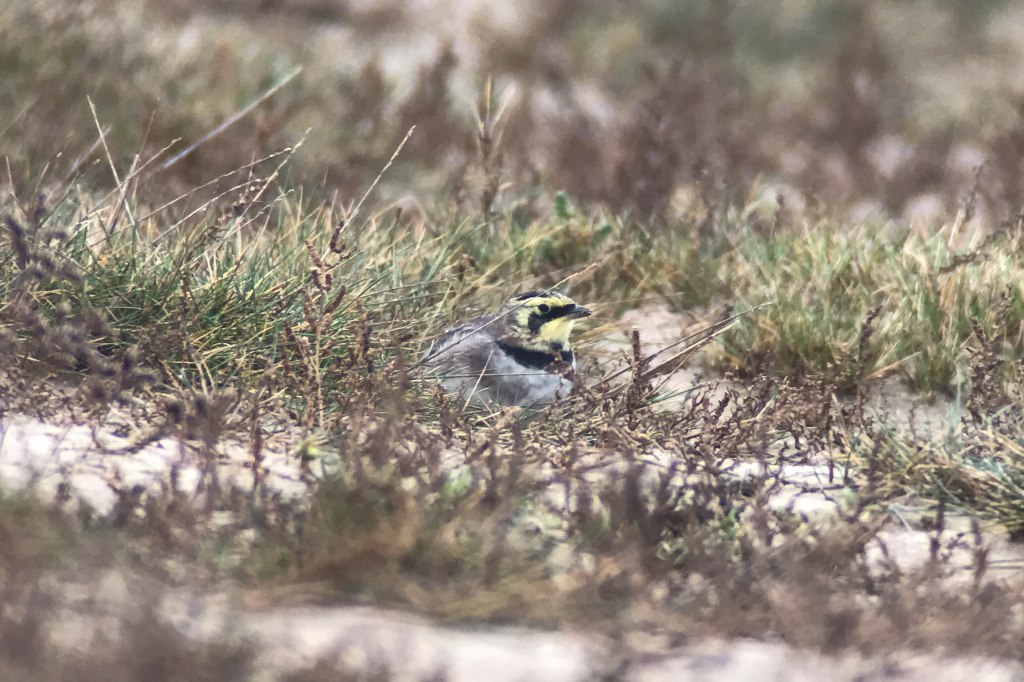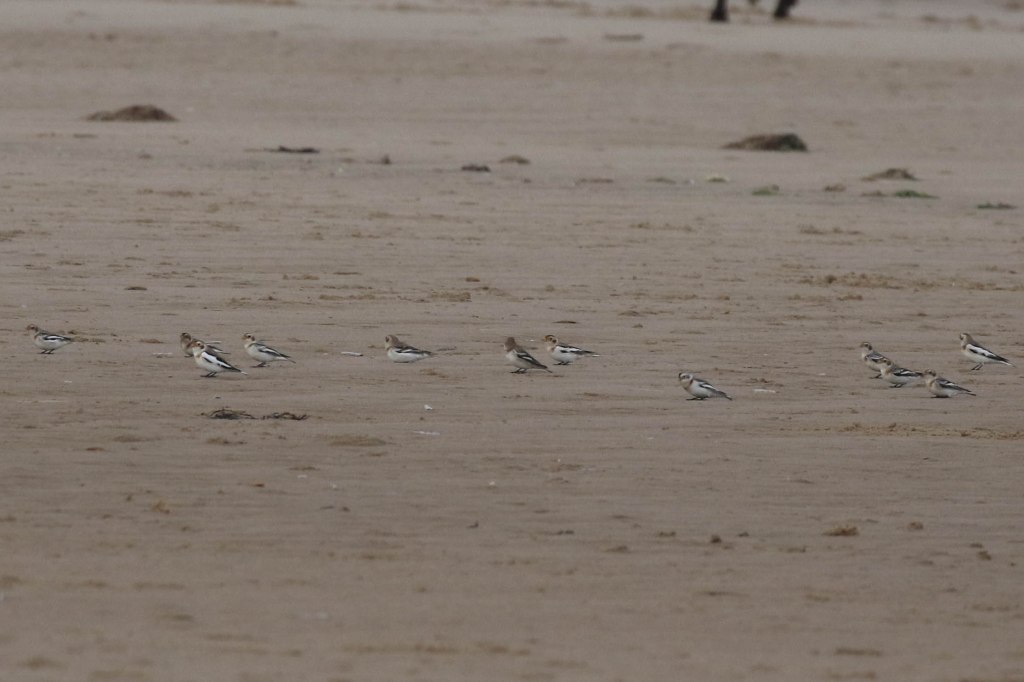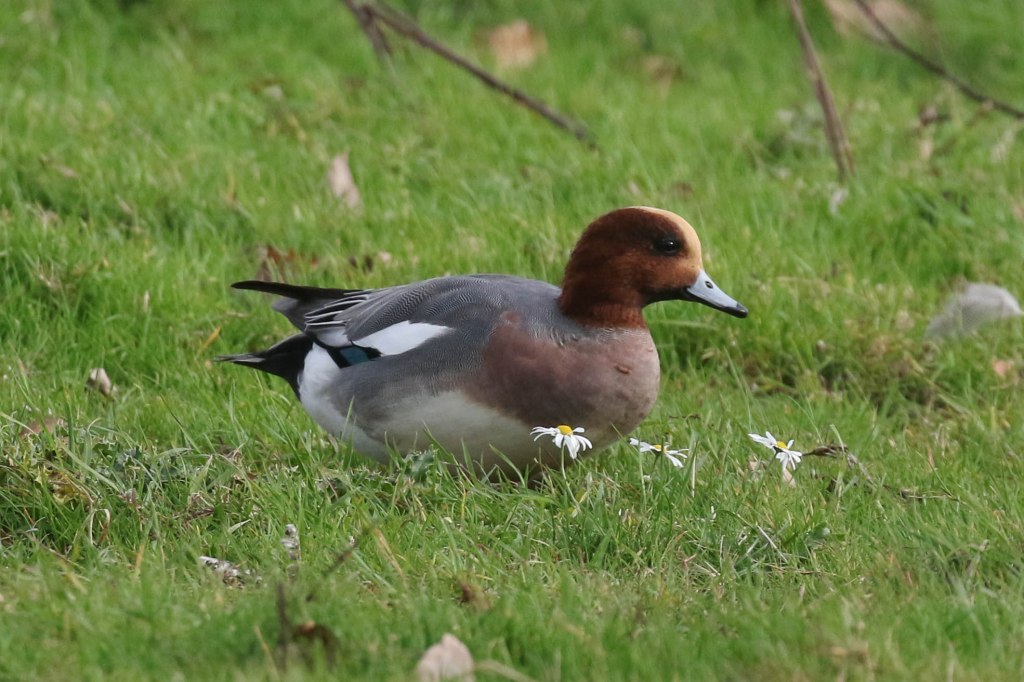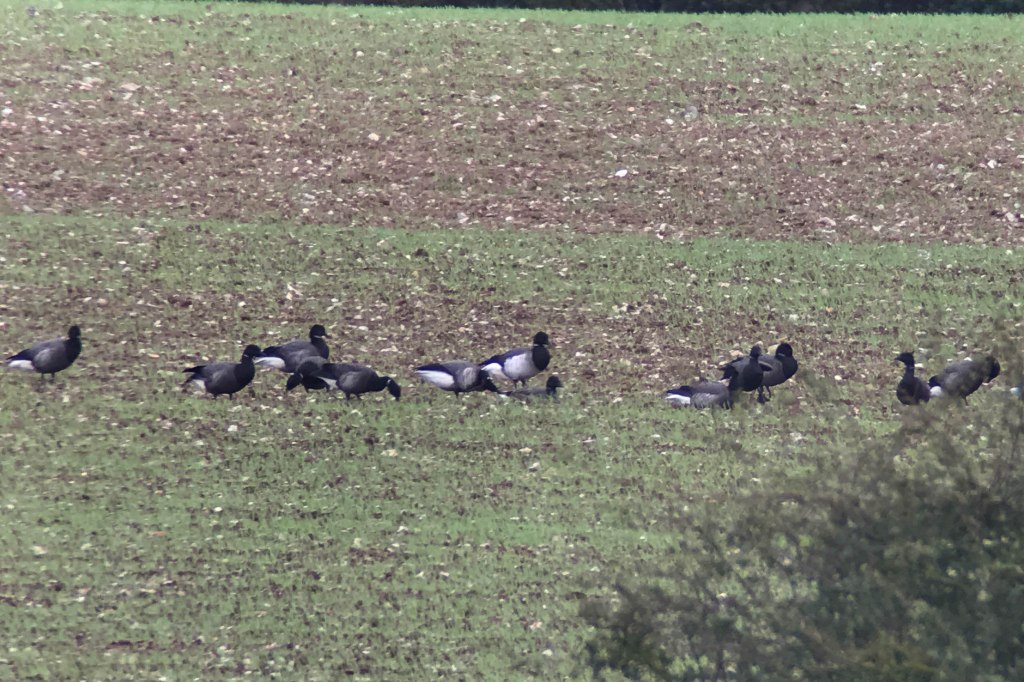Day 1 of a three day Late Autumn Tour in Norfolk. It was a rather blustery day, bright and even sunny at times, but with some squally showers which we thankfully largely managed to avoid.
We started the day at Holkham. As we drove up along Lady Anne’s Drive, we could see a Great White Egret out on the grazing marsh among the cows. It’s large size was clearly evident, next to the cattle, and when we got out we could see its long yellow dagger-like bill through the scopes.
There was lots of other life out on the grazing marshes. Lots of Wigeon and a Curlew in with them; a distant Common Buzzard perched on a bush at the back; a Red Kite drifted over in front of us.
Small groups of Pink-footed Geese were constantly flying over calling, very much the sound of the winter here in Norfolk. We could see some on the other side of the drive feeding on the grass behind the reeds, so we walked up to the far end where we could get a clear view. Through the scopes, we got a great look at their delicate pink-banded dark bills and pink legs. A pair of Egyptian Geese flew in and landed behind them and a Red-legged Partridge ran across the grass just behind.

There were a few Blackbirds feeding on the grass below the hedge, but no other thrushes with them today. We did have a small flock of Redwings fly over though, and their were obviously other birds moving this morning – small flocks of Starlings heading on west, Siskins and Chaffinches over calling, and three Skylarks overhead. The Jays flying in and out of the trees too, though it is always hard to tell here whether they are just local birds or travellers from further afield.
One of the regular very pale Common Buzzards circled out of the trees, always a pitfall for the unwary here and regularly misidentified as something rarer. We could see the rather diffuse pale base to its tail as it circled. A more distant Marsh Harrier out towards Decoy Wood was our first of the trip, a young bird, very dark with just a paler head.
As we made our way over the boardwalk and out to the beach, a Goldcrest was flitting around in the bushes in the dunes. We often get migrant Goldcrests here at this time of year, though they have been in short supply this autumn so far and again it is hard to tell whether this one could just as easily have been a local bird dropping out of the pines to feed. Either way, it is amazing to think something so small could make it all the way across the North Sea.

There were more finches moving along the edge of the pines, mainly Chaffinches and Siskins flying over calling as we walked west along the edge of the saltmarsh. A Great Spotted Woodpecker and a lone Redwing flew over too.
The saltmarsh itself here was quiet today. A Little Egret flew up from the channels out towards the dunes and in towards us. A dead Guillemot had washed up along the tideline – there has been a rather worrying wreck of them this autumn, and at this stage it is still not entirely clear why.
At the corner of the cordon, we stopped to scan and immediately spotted the Shorelarks down at the far end. So we walked on a bit further, and got them in the scopes. There were four Shorelarks here today – visitors from Scandinavia and just arrived in the last couple of days, hopefully they will now stay with us for the winter and maybe be joined here by a few more. We had a great view as they picked around the sparse saltmarsh vegetation looking for seeds, working their way slowly towards us and eventually close past us.

With our main target here achieved, we continued on out to the beach. There were three dark juvenile Gannets plunge diving just offshore and a scattering of Guillemots and Razorbills out on the water. A brief shower blew in behind us, but we were sheltered in the lee of the dunes and it passed through quickly before the sky cleared and the sun came out.
Turning our attention back to the sea, we picked up a couple of small groups of Common Scoter bobbing out on the waves, although they were a little distant and not easy to see. A couple of silvery grey and white winter Sanderlings were running up and down on the shore in front of us.
Here too there were birds on the move. Several small groups of Brent Geese flew past out over the sea, and two Shelduck flew past – possibly freshly arrived back in from their moult migration to the continent. Some very distant flocks of Dunlin flashed grey and white in the sunshine as they passed. There was also a constant arrival of small flocks of Starlings coming in from the continent for the winter.
We walked back along the beach, hoping to find some Snow Buntings. We hadn’t gone too far when we stopped to admire a Common Gull on the shore. The auks were much closer here, in the surf just behind. While we were watching those, one of the group spotted a flock of small birds land on the beach further up towards the Gap. Snow Buntings! We turned the scopes on them and watched them scurrying about on the sand, with crowds of people and dogs passing by just beyond them.

The Snow Buntings flew up into the edge of the dunes, twelve of them, up into the edge of the marram. They didn’t seem to mind the people sitting around here, so we walked up for a closer look. We had great views of them here. One or two Meadow Pipits and a Reed Bunting appeared with them here too.
We stopped here to scan the sea again. There were several Red-throated Divers and Great Crested Grebes close in this end, but we couldn’t find anything else. So we decided to make our way back. As we rounded the corner of the dunes, we realised how much the wind had picked up now. Heads down, we made our way back in over the saltmarsh, where a large flock of Linnets flew up and whirled round before dropping down into the vegetation.
It had been a very successful morning, so when we got back through the pines we decided to break for lunch in The Lookout. It was still nice and sunny here when we finished, but we could see a dark shower cloud away to the west which thankfully missed us.
We scanned the grazing marshes, hoping to find the covey of Grey Partridge which is often here. We couldn’t see any sign today, but we did pick up a Kestrel which seemed to be feeding on something down in the grass. A flock of Greylags flew in honking noisily and landed away to our left. Looking over, we could see they had joined a small group of Pink-footed Geese down in grass, giving us a nice side-by-side comparison. A few Canada Geese further back were an addition to the trip list.
As we walked back to the minibus along Lady Anne’s Drive, two Great White Egrets were now chasing each other around the grazing marshes. The Wigeon and Pink-footed Geese were now very close to the fence, so we stopped for another quick look, admiring the variation in the drake Wigeon at different stages as they emerge from their drab eclipse plumage. Some of them are already looking very smart.

We drove back through Wells next, and stopped at the pools just east of town. As we got out of the minibus, we heard a Water Pipit call overhead and looked across to see two or three pipits drop down into the long grass west of the track. We scanned around the pools and found a few Meadow Pipits and a couple of Pied Wagtails here too before eventually two Water Pipits appeared. We managed to get a look at them in the scopes but they were rather flighty in the wind and eventually flew off high over the track and away to the east.
Otherwise, there were lots of Egyptian Geese and Wigeon out on the grass here and a single Redshank on the pools which are still haven’t refilled much. We turned our attention to the larger pool to the east of the track next. There were more Wigeon on here and as we started to scan through a Ruff flew across in front and landed out of view behind the rushes. We were going to walk down the track to look for it, but we could see very dark clouds to the west and it was already raining hard over the fields towards Wells, so we decided to wait. It was a good call, as it soon started to rain here and we took shelter back in the minibus.
Thankfully the rain passed over very quickly with the blustery wind, and it soon brightened up again. A male Marsh Harrier now flew in over the grass to the west and landed briefly for a drink at the pool at the back. Scanning the pool to the east again, a Black-tailed Godwit dropped in briefly before flying off west over the track. A flock of Golden Plover circled over in the sunshine, flashing alternately gold and white, before disappearing off back over the fields towards the saltmarsh. A Brown Hare ran across the grass in front of us.
We could see a line of gulls standing out in the shallow water and scanning through at first we could see mostly Black-headed Gulls and one Great Black-backed Gull. When we got to the end of the line we found a single adult Mediterranean Gull – it stood out noticeably with its pure white wing tips and heavier red bill.
There was a small flock of Brent Geese in the distance in a winter wheat field beyond the pools. In the sunshine, one shone noticeably paler than the others as it turned, so we quickly got it in the scopes. It was a single Pale-bellied Brent Goose, a much scarcer subspecies here, in with the much commoner Dark-bellied Brent Geese which always winter here from their breeding grounds in Siberia.

With the improvement in the weather, we finally set off for the planned walk down the track. A Common Snipe flew past. There were several Meadow Pipits picking around out on the mud, but nothing with them now. A couple of Common Buzzards were perched on the tops of the bushes at the back and a male Marsh Harrier flew in over the fields beyond.
From the far end of the track, we looked back into the far corner of the eastern pool. We could see several Black-tailed Godwits feeding in the deeper water here now, but no sign of the Ruff we had seen earlier. A couple of distant Shoveler were right over at the back.
Continuing on through the bushes and up onto the seawall, we scanned the saltmarsh. There were a few Little Egrets out here, several Curlews on the mud, a group of Redshanks roosting on mud on edge of channel and we picked up a single Grey Plover out on the vegetation. A distant Marsh Harrier quartered out towards East Hills. As we walked down to scan the westernmost pool, an adult Peregrine flew in past us, before disappearing off over Wells.

There was nothing of note on the pool, so we walked back along the seawall and continued on along the coast path through the small copse. There were still birds moving at this late stage of the afternoon – a small flock of Siskin flew past us along the hedge line and carried on west, followed by three Chaffinches.
We walked a short distance further before stopping to scan out over the saltmarsh. Several Marsh Harriers were still out hunting, flying back and forth. A Merlin zipped low across at the back, before we lost sight of it in front of the dunes of East Hills. Then we picked up a distant Short-eared Owl circling in very high over the dunes. Not a great view perhaps, but interesting nonetheless – possibly a new arrival, fresh in from the continent.
We were hoping for a Hen Harrier, but we had managed to see everything but instead! Perhaps it was still a little too early in the evening – after the earlier showers, it was bright and sunny but cool now, and the wind had dropped noticeably. They were probably taking advantage of the improvement in the weather to stay out hunting until the last. We would have other opportunities, and it was unfortunately time to head back now.
Back at the minibus, as we were packing up, we heard Grey Partridges calling in the stubble field behind. We walked over and scanned and picked out some heads coming up from time to time out of the cut stubble towards the top of the brow. We got the scopes on them and eventually they came out into view, running across the field, a small covey of them.
It was a nice way to wrap up our first day. We had been very successful today – hopefully more to come tomorrow.
















